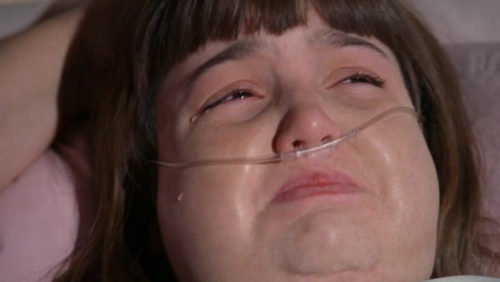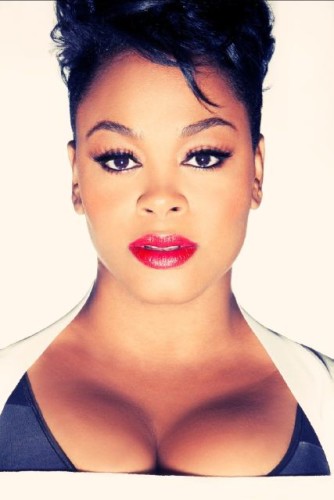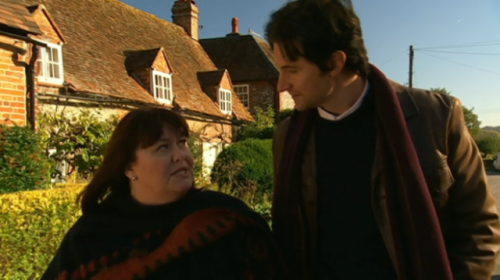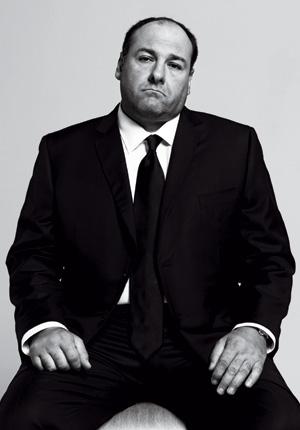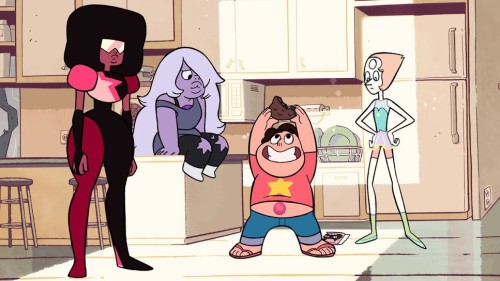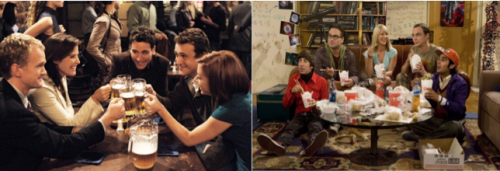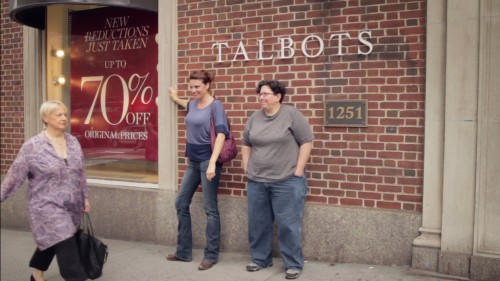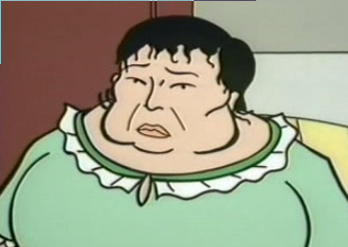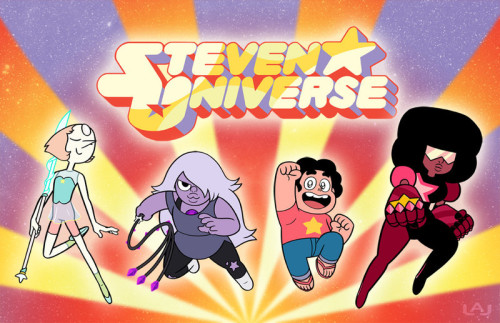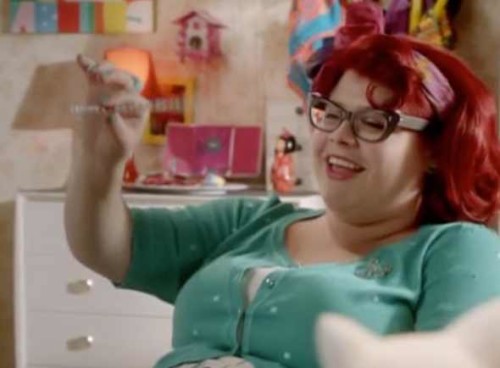
This guest post by Anthony DellaRosa appears as part of our theme week on Fatphobia and Fat Positivity.
Steven Universe is a kids’ cartoon show that’s made a lot of noise lately, especially in circles having to do with feminism or social justice, and looking at even the most basic summary of the premise, it’s not hard to see why. For one thing, the show stars a radically non-nuclear family. For another, it’s a family made up partly of a son who totally disregards the conventional standards of modern American masculinity and three adoptive moms, all of whom are non-binary people who choose to use feminine pronouns, two of whom are strongly coded as People of Color, and one of whom is literally the physical manifestation of the unconditional love between two same-sex lovers who actually share a kiss on-screen.
Now, that’s a lot to take in, and if you’re not previously familiar with the series, it might already sound a bit overwhelming, but the important thing to remember is that any show that can help teach our kids about the diversity that exists in our world instead of flagrantly ignoring it — and, specifically, anything that can do that teaching in a colorful, exciting, adventurous way that can also spark their creativity — is something worth looking at. And that’s Steven Universe in a nutshell. Of course, we can dissect the show’s approach to diversity in any number of ways with any number of focuses, but the one that’s perhaps the most immediately evident, requiring nearly no specific in-depth knowledge of the lore and mythology, is the very visible presence of many, many fat characters in the show’s core cast. So, how does Steven Universe tackle weight?

Well, the main character is Steven himself (voiced by Zach Callison). Steven is a boy who sits right on the line that divides childhood from adolescence, and in the show, he’s specifically defined by his incredible empathy and his unparalleled protective instincts. Those are the elements of his character that make him a hero, the elements that allow him to see any situation through to the end with the best possible results, and those are the elements that his weight serves to underline. He is soft. He is round. He is squishy and loving and completely without pretense. There is no guarding wall around his heart, no desire to compete with other boys, no need to be seen as “cool” or “tough” or “edgy,” and no compulsion to become anything other than what he already is because he knows that “what he already is” has value. That’s not to say that he’s necessarily complacent – because he’s incredibly energetic and always eager to learn new things about life, about himself, and about the world around him. It simply goes to say that he is consciously aware that, whatever else happens, he has an intrinsic worth that can never be diminished as long as he keeps his mind open and his heart warm. He is effortlessly endearing and unabashedly vulnerable, and that is what makes him strong.
Steven’s mother, Rose Quartz (voiced by Susan Egan), is also fat. As a matter of fact, she’s canonically over eight feet tall, and she wears a 2XL T-shirt, which fits snugly, with pride. She is unapologetically huge in every possible regard — in height, in weight, in love, in mercy, in joy, in optimism — and she is completely and unflinchingly comfortable within her own skin. She is beautiful, inside and out, and that’s just not my own personal judgment. That is a fundamental fact of the series, an opinion shared by every character who ever knew her and every character that matters, including her most bitter and longstanding enemies. That belief is a condition of entry for any aspiring viewer. It is necessary. It is real.

Now, Rose is a lot of things in this show. She’s a mother, first and foremost. That’s how we’re initially introduced to her, more or less — as the saintly woman who, in the series’ backstory, traded her own life force to bring Steven’s into existence, and her weight does emphasize the cuddly, maternal aspects of her character. She’s pillowy and soft. She’s warm and round and comforting, without any sharp edges, devoid of all straight lines.
But she’s also a warrior. She’s fat, beautiful, feminine, maternal, and the cunning leader of a ragtag alien strike team who came to Earth over six thousand years ago to conquer and colonize it for an outer-space empire, but when she found the planet and its people too rich and too precious to harm, she turned traitor. She stood on the front lines of a war against her own kind as Defender of the Earth, and because she loved the members of her team, and because they loved her back, they stood with her, protected in battle by her legendary shield, and they won. She is fat, and she is beautiful, and she is cuddly and soft with a big, goofy smile and huge, expressive eyes, and she is also the glorious rebel queen who saved a planet from an imperialist regime, and the wonderful thing about this show is that none of this — absolutely none of it — is ever presented as a contradiction. It’s not “oh, she’s fat, but she’s beautiful” or “she’s fat, but she’s strong.” There is no doubt, no dismay, no disbelief, and no fanfare for the fact that she can be all these things at once. It’s a given. She’s fat, she’s elegant, she’s drop-dead gorgeous and wickedly silly, she’s a mother, she’s a commando, and she’s so much more all at once because, simply, why not? Why couldn’t a person be all those things?

Rose exists to show the kids at home that a person can be endlessly generous, magnificently compassionate, feminine, flowery, funny, principled, decisive, and completely kickass while also refusing to be ashamed of her curves, rolls, folds, and bulges.
Of course, if Steven’s mother is the kind of person we can all aspire to be like, Steven’s father, Greg (voiced by Tom Scharpling), is more like the kind of person we might see every day. Greg is fat. He’s also technically homeless, living in the same old broken-down, rusted-out hippie van he had when he was a teenager, and, frankly, homeless people and fat people do end up on the receiving end of a lot of the same stereotypes. They’re lazy. They’re dumb. They have no ambition. They have no drive, perseverance, or passion. They have no self-control. They’re pathetic, contemptible, a burden, or an eyesore. They’re an unsightly, unseemly, disgusting waste. But that’s a list of everything Greg Universe isn’t. It’s not that he has no drive, and it’s not that he has no passion. It’s that, in a world controlled by the wealthy for the wealthy, even the hottest passion and the hardest work in the world make for no guarantee of comfort or success. Unlike Rose Quartz, Greg Universe is a product of the planet Earth, and the planet Earth is not a meritocracy. People don’t just get what they deserve here, so Greg was chewed up, spit out, and left to pick up the pieces on his own, with no support and no safety net, by a series of institutions that were never designed to work in his favor, and his weight, like his living conditions, can easily be read as a function of modern American economics. Greg keeps his head above water — barely — by working every day at a car wash at the edge of town, and for people like that, for the working poor, meals, by necessity, have to be cheap, easy, and quick, and it’s not a coincidence that the cheapest, easiest, and quickest-to-make meals in the country tend overwhelmingly to be the greasiest and the most fattening. Healthy eating is not a privilege we can assume Greg has, especially when the only prominent purveyors of food in the show are a donut shop and a French fry stand, and that reflects a truth that affects millions of people every day, generation after generation.

Still, while Greg’s weight is a constantly present piece of his character, very little — if any — specific attention is actually ever drawn to it in dialogue. Instead, the show’s focus consistently rests upon his grief for his wife, his bombastic love for his son, and his tremendous (if not profitable) expertise in the fields of music and sound design. He’s a hardworking, vulnerable, sincere, and well-meaning man who tries his best to be there for the people who need him, and in a show full of sweet people, he’s one of the sweetest of all. He is fat, and he is kind, and his son wouldn’t have him any other way.
The only main character who ever gave me a bit of pause on a personal level is Amethyst (voiced by Michaela Dietz), one of the members of Rose’s old rebel team and one of Steven’s current guardians. Amethyst is short, stout, and pudgy, and at first glance, her character actually does seem deliberately designed to invoke a lot of the most degrading fat stereotypes. She’s wasteful, rude, crude, generally unmotivated, unorganized, full of obviously bad ideas, and low on impulse control. Now contrast that with her foil, Pearl (voiced by Deedee Magno Hall), who is a fastidious, relentlessly goal-oriented perfectionist with the rail-thin body of a ballerina, and it becomes more than clear why the creators of this show designed these characters the way they did: They were channeling one-dimensional stereotypes and the shallowest expectations of the audience to shape these characters and inform their traits. Of course the perfectionist is thin and the loud, immature, goofy slacker is fat. Of course they are — because fat is imperfect, right? Fat is wrong. Fat is bad. So, the perfectionist wouldn’t be fat, would she? The lazy one is fat. The gross one is fat. That’s what the audience expects because that’s what the old stereotype is, so that’s what the creators of this show did when they made these characters: They tailored them to specifically fit the stereotypes for maximum convenience in lieu of more creative, subversive, or interesting concepts.

That bothered me for a long, long time. It didn’t invalidate the good the show was doing, but it certainly accounted for quite a bit of bad, and it colored the way I saw the show and limited who I felt comfortable recommending it to, but then came an episode called “On the Run,” which honestly changed a lot about how I thought about Amethyst as a character. She was the star of the episode, which was all about her self-image, her self-esteem, her most deep-seated insecurities, her worst fears, and her biggest, proudest, most personal victories. The big takeaway from the episode was that Amethyst isn’t Rose. She’s not graceful. She’s not perfect. She isn’t always comfortable in her own skin, and she isn’t always okay with being who she is, with being born where she was, or with feeling the way she so often does. Deep down inside, she can actually be viciously self-loathing, and she does what she can, day to day to day to day, to be happy, to be comfortable, and to care for herself, and in the episode, the point is made explicitly that there is no one alive who has a right to try and judge her or make her feel bad for that. She is who she is, even if “who she is” isn’t always conventionally appealing or easily digestible to more quote-unquote “mainstream” sensibilities. Her fundamental rights to dignity and happiness are completely inalienable, and anyone who dares to infringe upon them is doing something unspeakably despicable.
In a way, she’s a lot like Greg — a necessary and more realistic counterpart for Rose and, to an extent, a counterpart for Steven. The way Rose is written and portrayed, she’s effectively a goddess on Earth, a perfectly balanced master of all things who demonstrates what we can all aspire to, and Steven follows in her footsteps. But Greg and especially Amethyst show us that we don’t always have to be like that and that it’s okay if we’re not. They show us that, as imperfect as we can be sometimes, we are still beautiful, loveable, admirable, and valid, and at the end of the day, even if Amethyst has a unique outlook on life and a bawdy sense of humor, she’s portrayed as no less heroic and no less worthy of worship and care. Steven looks up to her just as much as he looks up to Rose and Pearl and all the others, and she lays down her life to protect the beauty of the Earth and every single living being on its surface every bit as quickly.

And, after all, that is the key idea. In the end, Steven Universe is a show that doesn’t always get everything right and certainly isn’t always perfect, but it’s a show built around the idea that all life, regardless of where it comes from or what it looks like, is inherently precious and worth protecting, and the creative team’s steadfast dedication to building an emotionally complex, rich, and diverse cast is a demonstration of its commitment to that concept.
Recommended Reading: How Does Steven Universe Expand Our Ideas of Family?, Steven Universe: One of the Most Positive, Progressive, and Affirming Shows on TV, Throwing Popcorn: Steven Universe
Anthony DellaRosa is an amateur critic and aspiring author with a particular passion for the stories we tell our children. He can be found on his blog, where he does informal reviews of movies, TV shows, video games, and books, and also on Twitter.

